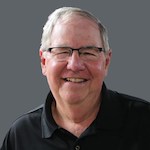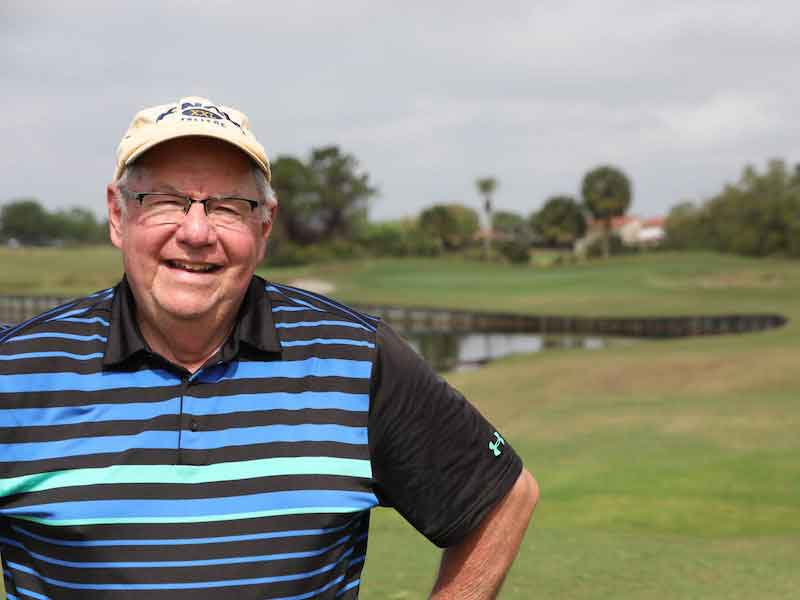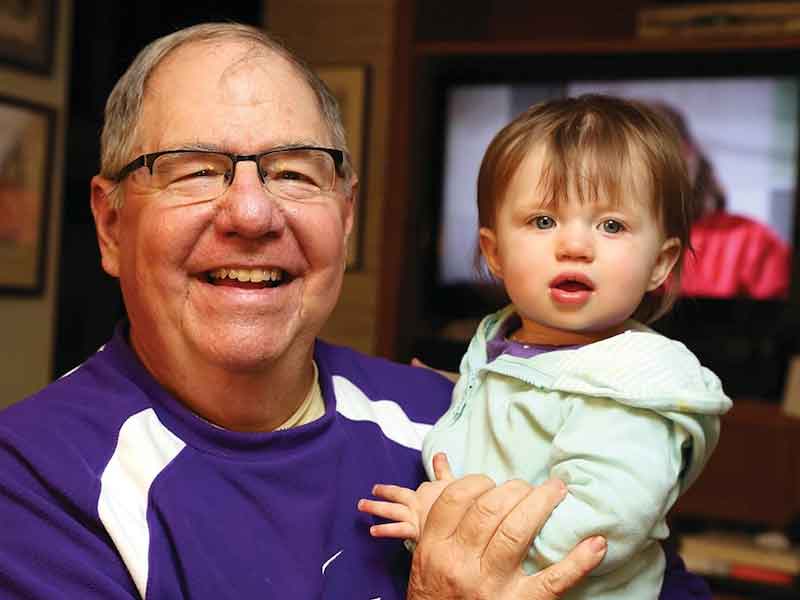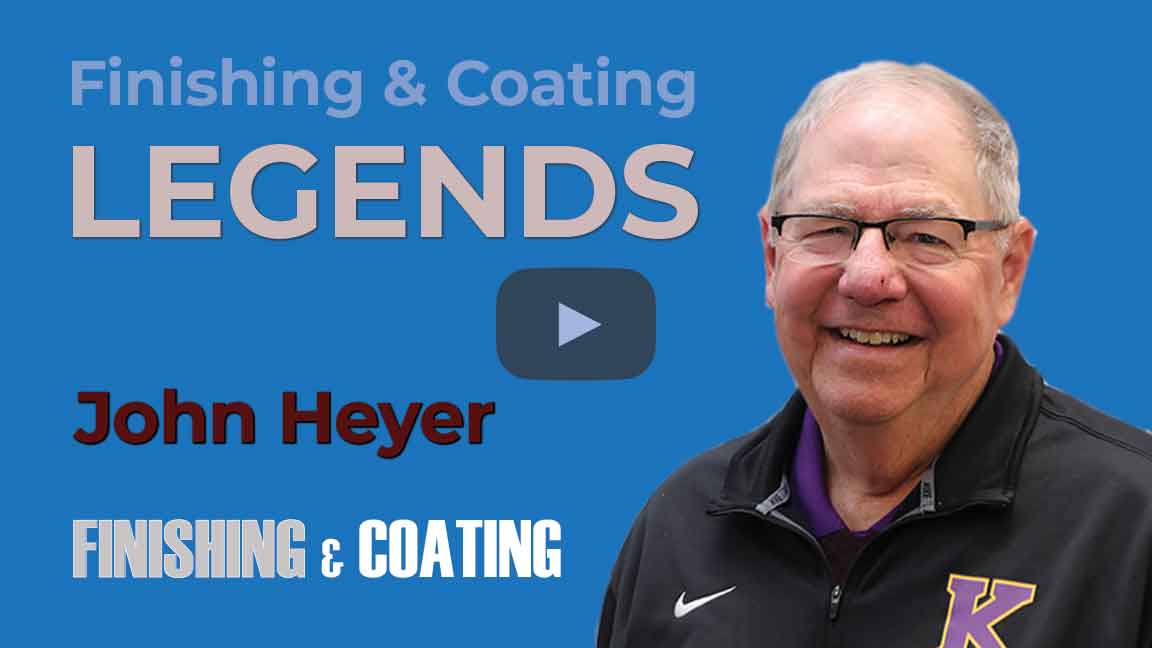John Heyer will be the first to admit that he took a job in the coatings industry simply because he needed a job back in the early 1970s.
 John HeyerBut what he did with that opportunity led him to a remarkable career that included finally owning the company he went to work for, as well as decades of activism in industry trade associations that culminated in being inducted into the Powder Coating Institute's Hall of Fame this year.
John HeyerBut what he did with that opportunity led him to a remarkable career that included finally owning the company he went to work for, as well as decades of activism in industry trade associations that culminated in being inducted into the Powder Coating Institute's Hall of Fame this year.
"It's a career I look back on with very fond memories," says Heyer, who is now retired from Kettle Moraine Coatings in Jackson, Wisconsin. "My business in the finishing industry is what provided the income for our family and put food on the table for over 40 years. Beyond that, it has been a great experience getting to know and interact with all the wonderful people in our industry."
Joined Powder Coating Industry in 1972
 John Heyer owned Kettle Moraine Coatings for several decades, and is now in the Powder Coating Institute's Hall of Fame.Heyer began in the powder coating industry when it was basically still in its infancy in 1972. To say the least, the equipment and processes back then were nothing like the technology that is present today.
John Heyer owned Kettle Moraine Coatings for several decades, and is now in the Powder Coating Institute's Hall of Fame.Heyer began in the powder coating industry when it was basically still in its infancy in 1972. To say the least, the equipment and processes back then were nothing like the technology that is present today.
The equipment required color changes to take at least an hour, he says, and the minimum order for a special color for most powder companies was 2,500 pounds. Heyer says most powder companies had color charts and stocked those materials, but beyond that, you needed to be able to order the minimum if you wanted a different color.
"There was no such thing as metallics or other special effects," he says. "The first major inroad into special effects was hammertones. These were dry-blended products where the exact effect depended on the guns you used and varied all over the map if reclaim was introduced."
Collecting reclaim and using it was a very inexact science, Heyer says, and you pretty much had to have a system that only ran a few colors. One way companies managed more than one color was to buy more than one system with booths sliding in and out of the line, he recalls.
"Achieving a true Class A finishes was not possible," says Heyer. "While there was much exuberance in 1972 of powder being the answer to environmental issues, the realities of assorted shortcomings gradually set in. There was a sense for a while that powder would have its place in certain industries and situations, but the thought was there were definitely limits. One by one, over time, these limits have been dealt with, and of course, things are different 50 years later."
Starting Kettle Moraine Coatings in 1975
 Heyer started in 1972 at KMC Coatings, the predecessor to Kettle Moraine Coatings, which was the coatings division of a stamping company. The owner approached his boss to see if there was interest in the management team buying the custom coating division. Heyer and two others started on their own as Kettle Moraine Coatings in 1975.
Heyer started in 1972 at KMC Coatings, the predecessor to Kettle Moraine Coatings, which was the coatings division of a stamping company. The owner approached his boss to see if there was interest in the management team buying the custom coating division. Heyer and two others started on their own as Kettle Moraine Coatings in 1975.
He became the sole owner of Kettle Moraine Coatings in 2003. In the early years, they did only about $500,000 in annual business with about 15 employees and had a building with about 30,000 square feet. When Heyer sold the company a few years ago, it did $5,400,000 in volume, had about 55 employees, and its building had grown to about 55,000 square feet.
There were only a few "true" powder coating installations in place in the early 1970s, Heyer says, as many companies were jumping in to participate. He says some were companies that did custom painting, and others were companies that had been doing what was called "plastic coating."
"They were doing plastisol and fluid bed coating and saw powder coating as a good way to grow," Heyer says.
Mentors Played Key Role in Heyer's Career
A company that did both wet painting and fluid bed coating in Milwaukee was Wright Metal Processors. Jim Wright was the founder, and Heyer says he was mostly a wet painter but had begun doing some fluid bed work also. Even though in the fluid bed arena Wright was a competitor to Kettle Moraine, Heyer says somehow Wright took a liking to him and was very helpful.
"This gave me an early lesson that you did not have to dislike your competitor," he says. "I also got to know Jim's son, Dave, who was probably about my age. He was first at Wright Metal but later at a number of pretreatment companies."
Dave Wright was instrumental in the building of the Chemical Coaters Association International, first in Milwaukee and later nationally. Heyer says with virtually every player in powder being new to the market; there was an entrepreneurial characteristic to the industry.
"There were a number of real characters who I got to know in those early years who helped me a lot," he says.
One of the very first he met was Andy Provost, who was selling vinyl powder for Thermoclad in Erie, Pennsylvania. Most of the vinyl was used for the fluid bed process, and Provost was particularly interested because before Thermoclad, he had spent several years working for another pioneering plastic coating company: Plastonics in Hartford, Connecticut, which was started by the Zimmerli family.
"I am now good friends with Bob —who is the second generation— and Brian, who is third," says Heyer, who also counts among his mentors the founder of Thermoclad, Al Renkis, and Ernie McClellan, who started Plast-O-Meric in the Milwaukee area.
Making Many Great Friends in the Coating Industry
 Heyer says he also learned a lot from powder salespeople from those beginning years: Stan Wenzel with Armstrong Products and later HB Fuller, and Stu McLaughlin, who was with Sherwin Williams and spent many years thereafter with Armstrong.
Heyer says he also learned a lot from powder salespeople from those beginning years: Stan Wenzel with Armstrong Products and later HB Fuller, and Stu McLaughlin, who was with Sherwin Williams and spent many years thereafter with Armstrong.
"On one of the first powder projects I was involved in, I worked with a formulator at Armstrong Products named Don Tyler," Heyer says. "In later years, Don was with a powder equipment company named Volstatic, which he eventually owned. They made very good and basic powder equipment that was perfect for custom coaters. In the 1980s, Volstatic virtually owned the custom coater powder equipment business."
Heyer says he has learned many things over the many decades he was a finishing owner, but one stands out: the need to adapt. He says technology is always improving, and coaters need to move with it.
"The kind of work we were able to do and prosper with in the 1990s changed drastically as we moved past 2000," Heyer says. "As a company, we needed to adjust. You need to learn from your mistakes; there will certainly be a few."
Good Advice for Coating Newcomers
Heyer says he advises people who are new to the coating industry to learn all aspects of the finishing processes and network, network, and network. He also advises never against carrying grudges or being bitter if something does not work out with someone.
"Back out gracefully because you never know when you might need that person sometime," Heyer says.
He also suggests people be involved with industry trade groups, such as their local CCAI chapter, which can be invaluable. Heyer has also been in two peer groups in my career, and he considers those memberships some of the best things he did.
Heyer says he has such fond memories of his career, and especially of working — and eventually owning — Kettle Moraine Coatings.
"We had a core of key people that came together in about 1990," he says. "This group stayed together all the way until I sold in 2019. There was a bond formed as we struggled at times —both in business and in our family lives — but over time, succeeded. I value all the people I have interacted with over the years, many of whom I consider good friends."




































